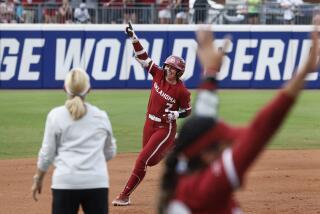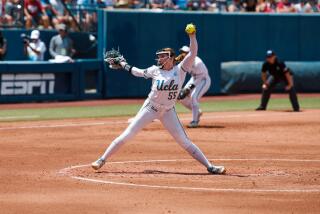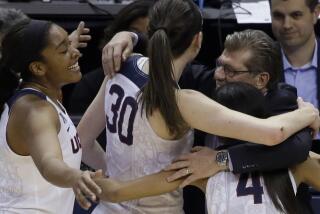Climbing the Charts
NORMAN, Okla. — Oklahoma Coach Sherri Coale remembers her disbelief in 1990 when she heard the news from another teacher at Norman High.
“Oklahoma just dropped women’s basketball.”
Coale, coach of the high school’s girls’ team at the time, was quick with her response.
“They can’t do that.”
Her fellow teacher shrugged: “They just did.”
Coale didn’t hesitate.
“Trust me, they can’t.”
She was right, of course.
Within days, a furor erupted at the women’s Final Four. A famous lawyer started preparing a Title IX lawsuit and soon Oklahoma’s athletic department reversed field faster than Billy Sims.
A dozen years later--and six seasons after Coale took over as Oklahoma’s coach--the Sooner women are 20-2 and ranked No. 4 in the nation.
So are the 19-3 Sooner men--a coincidence that makes Oklahoma the only school other than Duke whose men’s and women’s programs are in the top five.
In a state where football and wrestling cast large shadows, basketball is having its day.
It might not have the lore of Indiana or North Carolina, but Oklahoma has a rich basketball history.
Henry Iba won consecutive NCAA titles in 1945 and ’46 at Oklahoma State, once known as Oklahoma A&M.;
He coached in Stillwater for 36 years beginning in 1934, made Bob Kurland the first celebrated 7-footer and influenced coaches from Don Haskins and Eddie Sutton, who played for him, to Bob Knight, who considered him a close friend.
At Oklahoma City University, Abe Lemons kept the basketball world in stitches.
At Oklahoma, Billy Tubbs guided the Sooners to the 1988 NCAA title game against Kansas with a team that included Mookie Blaylock and Harvey Grant.
And Sutton returned to his alma mater in 1990, taking Oklahoma State to the Final Four in 1995, where the Cowboys and Bryant “Big Country” Reeves lost in the semifinals to UCLA’s last NCAA championship team.
It’s a state with a wealth of NAIA and junior college programs as well. But tonight, the eyes of Oklahoma fall on raucous Gallagher-Iba Arena in Stillwater, where the Oklahoma men visit 16th-ranked Oklahoma State in the season’s second episode of Bedlam, as the rivalry is called. (Oklahoma won the first game, 58-53.)
With a population that isn’t that much larger than Orange County’s, Oklahoma schools sometimes must search far a field for players.
“Think about it, it’s a state of three million people,” said Oklahoma Coach Kelvin Sampson, who took the Sooners to the Sweet 16 in 1999 with a team led by Mexico native Eduardo Najera.
“This year, there are seven or eight kids from Oklahoma who will play top-level Division I basketball. But typically, it varies from zero to eight. Some years, there are no kids at all recruited by OU or Oklahoma State.”
At Oklahoma State, Sutton has five players from Oklahoma, but the Cowboys’ best player is senior guard Maurice Baker, who went to high school in Illinois and played junior college ball in Utah.
Oklahoma has only two players from the state--led by junior Ebi Ere, a 6-foot-5 guard from Tulsa.
“He’s about as Oklahoma as you can get,” Sampson said.
“My father is Nigerian,” Ere said. “But I’ve never lived anywhere except Oklahoma and Kansas, when I went to junior college.”
The Sooners’ top scorer and emotional leader is junior guard Hollis Price, a New Orleans native who overcame a nasty injury in a first-round NCAA tournament loss last season that left a piece of an Indiana State player’s tooth in his right elbow and required three surgeries to correct.
“I’d never heard of Oklahoma,” he said, though he’s found a home there. “If I go out to a club in New Orleans, I might stay out ‘til 4:30. Here, everything’s closed by 2.”
It’s easier to find women’s basketball players on the recruiting trail in Oklahoma--partly because football and wrestling don’t drain away athletes--because girls’ basketball has a long tradition, even if it was the six-on-six variety for many years.
Five of Coale’s players are from the state--one of them Shannon Selmon, the daughter of Dewey Selmon of the famous Selmon brothers who played football at Oklahoma in the 1970s.
Another home-grown player is senior guard LaNeisha Caufield, one of 20 finalists for the Naismith national player of the year award.
But three of the Oklahoma women’s players are from Canada--including the best, Stacey Dales, a 6-foot senior point guard who played for the Canadian Olympic team in Sydney.
A first-team All-American last year, Dales is also among the Naismith finalists.
“I’m from the midst of big cities--Ottawa, Toronto, Montreal,” said Dales, who is from Brockville, Ontario. “No, to the common cliche, we don’t live in igloos.
“I had this girl in Oklahoma ask me, ‘Where’s Canada?’
“Of course, on the other side of that, I had said, ‘Where’s Oklahoma?’ I really did have to pull out an atlas and take a look at where Oklahoma was before I came here. But it’s a really simple place. I tend to be high-strung. I think it’s good for me.”
The feeling is mutual.
Coale took over in 1996, and it wasn’t until Dales arrived in 1998 that the program finally emerged from the uncertainty after its brush with death in 1990.
“I spent my first two years here just rehashing that,” Coale said. “Every home visit, if they didn’t know the history, the people recruiting against us certainly were going to tell them.”
These are heady days for Oklahoma basketball--and a good time for most Sooner sports.
The football team finished sixth in the nation, both basketball teams are in the top five, and men’s and women’s gymnastics, wrestling and softball are in the top 10.
The revenue generated by football helps, and Oklahoma doesn’t seem to have much difficulty with raising funds, either.
At the Lloyd Noble Center where Oklahoma plays basketball, a new $17-million, 63,000-square-foot addition is being completed.
There are joint medical and weight-room facilities for the men’s and women’s basketball teams, separate-but-equal coaches’ offices, film rooms and lavish locker rooms--along with pro-style players’ lounges equipped with a television, video games and overstuffed leather chairs.
Athletic Director Joe Castiglione--who arrived in 1998, long after the women’s basketball uproar--urged Coale and Sampson to ask for everything they’d want in the building.
The centerpiece is stunning twin practice arenas--one for the women, one for the men--that make the typical stories obsolete about men’s teams running the women off the court or forcing them to practice in the evening or wee hours of the morning.
With all they have in common, Oklahoma’s fourth-ranked men and women only hope they’ll end the season in the same place.
“We set a goal,” said Price, whose team has beaten No. 3 Maryland by 16 points at home but lost to No. 2 Kansas by eight on the road.
The players say it together in the huddle: “Final Four.”
The women have the same goal, and despite a 14-point loss at undefeated and top-ranked Connecticut, they say they’d like to see Coach Geno Auriemma’s team again.
“I think they’re the favorite,” Coale said. “But I don’t think the gap’s as large as before.”
*
(BEGIN TEXT OF INFOBOX)
Double Trouble
The schools that have had both men’s and women’s basketball teams ranked in the top four of the final Associated Press rankings, and how they performed in the NCAA championships
(text of infobox not included)


